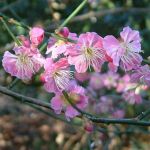| Common Name: |
Ume |
| Other Names: |
Japanese Apricot |
| Botanical Name: |
Prunus mume syn. Armeniaca mume |
| Genus: |
Prunus |
| Family: |
Rosaceae |
| Native Location: |
China, Japan, and Korea |
| Cultivation: |
Well-drained, neutral to alkaline soil in sun. Prunus laurocerasus tolerates shade. Prunus spinosa (blackthorn) is a useful plant for hedging in cold, exposed, or coastal ares. Prune fruiting specimens in summer to restrict growth and encourage formation of fruit buds. Trim P. laurocerasus in spring. Leaves and young shoots are often attacked by aphids and caterpillars. Likely diseases and disorders include peach leaf curl, bacterial canker, chlorosis, witches' broom, and honey fungus. Many Prunus species are relatively short-lived. P. laurocerasus may be affected by leafspot and powdery mildew. Most Prunus species are shallow-rooted and will sucker if roots are damaged. Early-flowering species are prone to frost damage. |
| Propagation: |
By seed sown in autumn (species only); by greenwood cuttings in early summer (deciduous species); by semi-ripe cuttings in summer (P. laurocerasus). Cultivars are budded in summer or grafted in early spring. |
| Harvest: |
Leaves (P. persica) are picked in summer and dried for infusions, or (P. laurocerasus) distilled for aqueous extract (cherry laurel water). Bark (P. africana, P. persica, P. serotina) is stripped in autumn and winter and dried for infusions, liquid extracts, powders, syrups, and tinctures; bark of P. africana is also processed for pharmaceutical extracts. Flowers (P. persica) are gathered in spring, and unripe fruits (P. armeniaca, P. domestica, P. mume, P. persica) in summer, and dried for decoctions. Fruits are picked ripe or unripe, depending on use; prunes (cultivars of P. domestica) are often left on the trees to dry. Seeds from ripe fruits are dried for decoctions (P. japonica) or crushed for oil (P. armeniaca, P. dulcis, P. persica). |
| Varieties: |
Benichidori
syn.Benishidore
Is shrubby, with deep pink flowers.
Height: 2.5m (8ft)
Width: 2.5m (8ft) |
Microcarpa
(ko-ume)
Has small fruits, pickled as ko-umeboshi (tiny salt "plums"). |
Peggy Clarke
Has double, deep pink flowers. Heavy cropping. |
|
| Height: |
9m (28ft) |
| Width: |
9m (28ft) |
| Hardiness: |
Z7-10 |
| Parts Used: |
Unripe fruits (wu mei) |
| Properties: |
An astringent, sour herb that expels intestinal parasites and stimulates bile flow. It is effective against many bacterial and fungal infections. |
| Medicinal Uses: |
Internally for chronic coughs, chronic diarrhea, and roundworms. Externally for fungal skin infections, corns, and warts. |
| Culinary Uses: |
Fruits are eaten raw, candied, preserved, or pickled, notably as umeboshi or salt "plums", which are colored using red shiso (See Perilla, Beefsteak Plant); also made into a liqueur, sour jam (ume-bishio), and "plum" sauce. |
| Warning: |
All parts of P. laurocerasus, notably the leaves and seeds, are harmful if eaten. Bitter-tasting kernels of Prunus species may be fatally toxic in excess. |
| Bibliography: |
The Encylopedia of Herbs by Deni Bown Copyright © 1995, 2001 Dorling Kindersley Limited pp. 331-333
|
